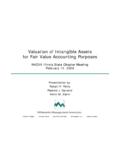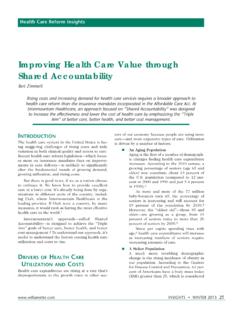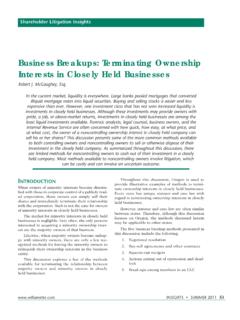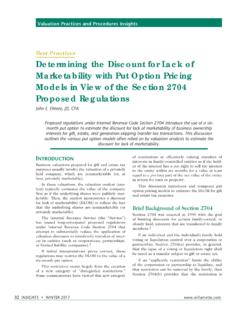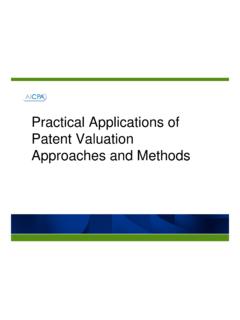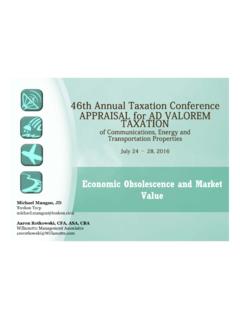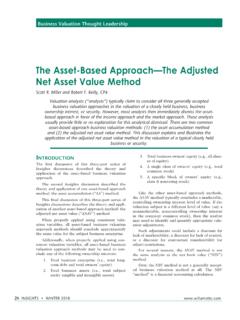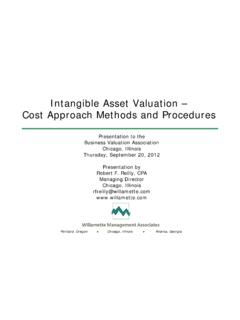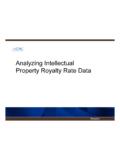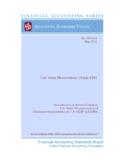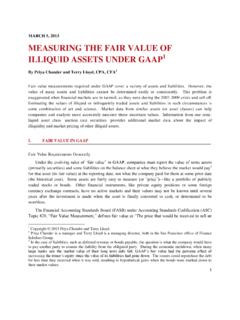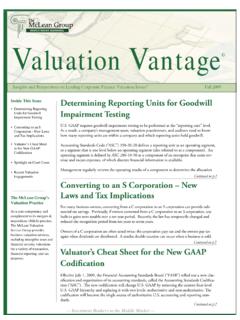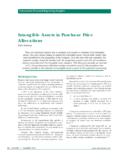Transcription of Is Fair Value Equal to Fair Market Value?
1 Portland, Oregon Chicago, Illinois Atlanta, GeorgiaIs fair Value Equal to fair Market Value ?(Is GAAP fair Value a Relevant Value Measure for Ad Valorem Property Tax Purposes?)NAPTR-TEC Annual ConferenceCharleston, South CarolinaOctober 25-26, 2011 Robert F. Reilly, CPAM anaging DirectorWillamette Management AssociatesChicago, Management Associates1 Discussion Outline GAAP Primer Who Sets GAAP? GAAP Primer Hierarchy of GAAP GAAP Primer When Does fair Value Apply? GAAP Definition of fair Value Common Definition of fair Market Value fair Value and fair Market Value Definitions are Similar Valuation Procedures and Assumptions are Different Level of Account Differences HABU Differences Allowed Methodology Differences Other Differences Illustrative Example of FV vs.
2 FMV Differences Summary and ConclusionWillamette Management Associates2 IntroductionWhy is this topic relevant to NAPTR-TEC? Property tax assessors look for the following types of transactions subject taxpayer (TP) is acquired and the TP assets are restated to FV subject TP acquires a target company and the target company assets are restated to FV industry competitor to the TP is acquired and its assets are restated to FVWillamette Management Associates3 Introduction (cont.) Property tax assessors will use these FV valuations as follows accept the FV of TP assets as the FMV of TP assets calculate FV to book Value (assets) multiple from other transactions and apply that FV/BV multiple to TP tangible assets calculate FV to BV (equity) multiple from other transactions and apply that FV/BV multiple to TP assets or TP equity use FV/BV (equity)
3 Transaction multiples to conclude there is no economic obsolescence in the TP or the industry These issues apply to centrally assessed unit Value taxpayers, but they also apply to some locally assessed summation Value taxpayersWillamette Management Associates4 GAAP Primer Who Sets GAAP? the Financial Accounting Standards Board (FASB) sets US generally accepted accounting principles (GAAP) the International Accounting Standards Board (IASB) sets international financial reporting standards (IFRS) IFRS are adopted in 110 countries in Europe, Africa, Asia, South America, and North America (except US) the FASB and IASB are working toward GAAP convergence for the last several years, all GAAP changes have been approved by both organizations currently, there are nearly identical fair Value measurement and disclosure provisionsWillamette Management Associates5 GAAP Primer Who Sets GAAP?
4 (cont.) on 5/12/11, the IASB issued IFRS 13 titled fair Value Measurementand the FASB issued ASU 2011-04 titled Amendments to Achieve Common fair Value Measurement and Disclosure Requirements in US GAAP and IFRS now, fair Value is defined the same, acceptable methodology is nearly identical, and disclosure requirements are largely the sameWillamette Management Associates6 IFRS and US GAAP fair Value Definition The price that would be received to sell an asset or paid to transfer a liability in an orderly transaction between Market participants at the measurement date. Willamette Management Associates72011 FV GAAP Changes IFRS 13 prescribes the same three-level hierarchy of FV measurement methods found in US GAAP IFRS 13 provides guidance on: making assumptions about markets and Market participants applying adjustments to actual Market transaction prices measuring FV when markets are inactive FASB accounting standards codification (ASC) 820 changes (from ASU 2011-04) clarify.
5 Applying HABU and valuation premise in FV measurements measuring FV of shareholders equity instruments for comp purposes making FV measurement disclosuresWillamette Management Associates8US GAAP HierarchyASC 105-10 identifies four levels of GAAP hierarchy:1. Level 1 (highest level) FASB statements and interpretations FASB accounting standards updates (ASU) APB opinions AICPA accounting research bulletins2. Level 2 FASB technical bulletins (FTB) FASB interpretations (FIN), FASB staff positions (FSP) AICPA industry audit and accounting guides AICPA SOPs3. Level 3 AICPA ACSEC technical bulletins FASB EITF consensus positions4. Level 4 (lowest level) FASB staff implementation guidesWillamette Management Associates9 When Does fair Value Apply in GAAP?
6 ASCFair Value TopicASC 805-20-30 Business combinations identifiable assets and liabilitiesASC 815-10-50 Derivatives and hedging disclosuresASC 820 fair Value measurements and disclosuresASC 825-10-25 Financial instruments the fair Value optionASC 350 Goodwill impairmentASC 360 Other long-lived asset impairmentASC 718 Share-based compensationWillamette Management Associates10 fair Value Definitions fair Value is defined in ASC 820 as the price that would be received to sell an asset or paid to transfer a liability in an orderly transaction between Market participants at the measurement date. An orderly transaction is a hypothetical transaction assumed to take place on the measurement date with the subject asset having been exposed to the Market for the usual and customary period of time for transactions involving such assets in order to provide sufficient time for marketing activities.
7 An orderly transaction is not a sale where the seller is under duress ( , a forced liquidation or distress sale).Willamette Management Associates11 fair Value Definitions (cont.) fair Value measurements are considered from the perspective of a Market participant that already holds the asset or owes the liability. The objective of measuring fair Value is to determine an exit price: the price that would be received to sell an asset or the price that would be paid to transfer the Management Associates12 ASC 820 fair Value Eight Steps1. Identify the item to be valued and the unit of Determine the principal or most advantageous Market and the relevant Market Select the valuation premise to be used for asset Consider the risk assumptions applicable to liability Identify available Select the appropriate valuation technique(s).
8 7. Make the Determine amounts to be recognized and information to be Management Associates13 ASC 820 Hierarchy of fair Value InputsLevel 3 InputsUnobservableLevel 2 InputsIndirectly ObservableLevel 1 InputsDirectly ObservableQuoted prices in active markets for identical assets orliabilities that the reporting entity has the ability to access atthe measurement date. Such prices are not adjusted for theeffects, if any, of the reporting entity holding a large block relativeto the overall trading volume (referred to as a blockage factor ).Directly or indirectly observableprices in active markets for similarassets or liabilities; quoted prices foridentical or similar items in markets that arenot active; inputs other than quoted prices( , interest rates, yield curves, credit risks,volatilities); or Market corroborated inputs.
9 Inputs thatare unobserv-able; that reflectmanagement s own assumptions aboutthe assumptions marketparticipants would Management Associates14 Item Identification and Unit of Account The same unit of account at which the asset is aggregated or disaggregated by applying other applicable GAAP is to be used for fair Value measurement purposes. ASC 820 prohibits adjustment to the valuation for a blockage factor. The blockage prohibition applies even if the quantity held by the reporting entity exceeds the Market s normal trading Management Associates15 Principal or Most Advantageous Market and Market Participants ASC 820 requires the analyst to maximize the use of assumptions (inputs) that are observable from Market data obtained from independent sources.
10 The analyst is to assume that the asset is exchanged in a hypothetical, orderly transaction between Market participants at the measurement date. To characterize the exchange as orderly, it is assumed that the asset will have been exposed to the Market for a sufficient period of time prior to the measurement date to enable marketing activities to occur that are usual and customary with respect to transactions involving such Management Associates16 Exit PriceFor valuing assets, exit price is the pricethat a reporting entity that holds the asset would hypothetically receive by selling it on the measurement Management Associates17 Highest and Best UseThe use of an asset by Market participants that would maximize its Value or the Value of the group of assets in which those Market participants would use it.
